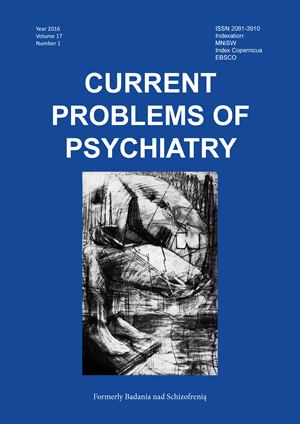Extraordinary system of delusions and the social functioning - a case study
DOI:
https://doi.org/10.1515/cpp-2016-0003Keywords:
delusions, social functioningAbstract
Schizophrenic psychoses are a heterogeneous group of diseases that affect about 1% of the world’s population. The first symptoms of the disease usually manifest between ages 20 and 30. The diagnostic criteria for schizophrenia and its subtypes are characterized in detail in ICD-10. Diagnosis is based primarily on the presence of productive symptoms such as delusions or hallucinations occurring for at least one month which cannot be explained in another way. Schizophrenia is a disease which largely affects social functioning of patients, such as occupational perfor-mance, family life, interpersonal relationships or housing situation. Apart from the sociological aspect, social lives of schizophrenia sufferers are significantly impoverished due to cognitive impairment associated with improper functioning of NMDA receptors. The study describes a case of a patient suffering from paranoid schizophrenia which sheds light on the social functioning of this group of patients.
References
1. Pużyński S., Rybakowski J., Wciórka J. Psychiatria: Psychiatria Klinicz-na, 2nd edition Elsevier Urban & Partner, Wrocław 2011: 195.
2. Klasyfikacja zaburzeń psychicznych i zaburzeń zachowania w ICD-10 badawcze kryteria diagnostyczne. Kraków-Warszawa; Uniwersyteckie Wydawnictwo Medyczne "Vesalius" Instytut Psy-chiatrii i Neurologii: 1998
3. Wright P., Stern J., Phelan M.: Psychiatria Sedno tom 2 Elsevier Urban & Partner 2005: 260-262
4. Heitzman J. Klasyfikacja zaburzeń psychicznych – koncepcyjne założenia ICD-11. Psychiatr. Pol. 2011; 45(6): 941-950
5. McGrath J., Saha S., Chant D., Welham J.: Schizophrenia: A Concise Overview of Incidence, Prevalence, and Mortality. Epidemiol. Rev. (2008) 30 (1): 67-76.
6. Häfner H.: Das Rätsel Schizophrenie: Eine Krankheit wird entschlüsselt. 2. Aufl. München; C.H. Beck: 2001
7. Cechnicki A.: Schizofrenia - proces wielowymiarowy. Instytut Psychiatrii i Neurologii, Warszawa 2011: 117, 157-167.
8. Rund BR, Sundet K, Asbjørnsen A et al. Neuropsychological test profiles in schizophrenia and non-psychotic depression. Acta Psychiatr. Scand. 2006; 113: 350-359.
9. Hoff A.L., Svetina C., Shields G., et al. Ten year longitudinal study of neuropsychological functioning subsequent to a first episode of schizophrenia. Schizophr. Res. 2005; 78: 27-34.
10. Fleury M.J., Grenier G., Bamvita J.M., Tremblay J., Schmitz N., Caron J. Predictors of quality of life in a longitudinal study of users with severe mental disorders. Health Qual. Life Outcomes. 2013; 11: 92
11. Breier A., Schreiber J.L., Dyer J., Pickar D. National Institute of Mental Health longitudinal study of chronic schizophrenia. Prognosis and pre-dictors of outcome. Arch. Gen. Psychiatry. 1991; 48(3): 239-46
12. Katschnig H. Schizophrenia and quality of life. Acta Psychiatr. Scand. Suppl. 2000; 407: 33-37
13. 13.Kirkpatrick B., Fenton W.S. Carpenter Jr. W.T., Marder S.R. The NIMH-MATRICS consensus statement on negative symptoms. Schizophr. Bull. 2006; 32(2): 214-219
14. Krzystanek M., Krupka-Matuszczyk I., Klasik A. Neurocognitive expression of hypofrontality in long term schizophrenia. Uehara T (red.) Psychiatric disorders - trends and development. InTech, Rijeka 2011, 93-106.
15. Krzystanek M., Piekarska-Bugiel K., Pałasz A., Martyniak E., Krupka-Matuszczyk I. Leczenie zaburzeń poznawczych - Święty Graal leczenia schizofrenii. Review of Clinical Neuropsychiatry. 2015; 7(1): 11-15.
Downloads
Published
Issue
Section
License
Copyright (c) 2016 Authors

This work is licensed under a Creative Commons Attribution-NonCommercial-NoDerivatives 3.0 Unported License.


